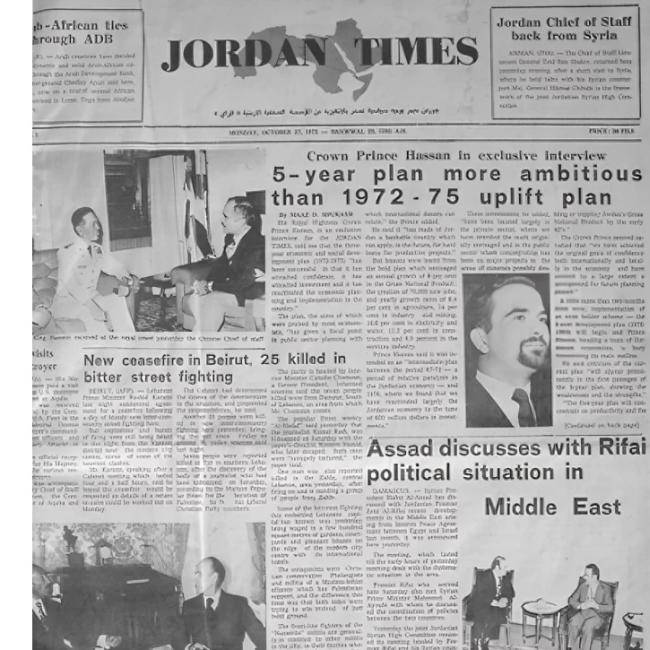The Jordan Times celebrates 50th anniversary
With the start of the Lebanese civil war in 1975, a major English newspaper in the region, The Daily Star, suspended publication, pushing officials and journalists in Jordan to consider filling that gap with a home-grown English paper, according to journalist Maaz Shukayr.
Shukayr, who was director of programmes at Radio Jordan at the time, was contacted by Jumaa Hammad, then director of the Jordan Press Foundation (JPF), asking him to help produce an English language newspaper to appeal to the foreign community in the Kingdom.
Hammad had in the 1960s worked with Shukayr on The Jerusalem Star, an English paper that was published for a year.
“I made all the preparations. Hired the people, made the subscriptions to the international news and photo agencies… and saw to it that we had a nice room furnished at the Jordan Press Foundation,” said Shukayr, who was a managing editor with the founding team of the JT, while Mohammad Al Amad assumed the post of chief editor.
The paper was supported by HRH Prince Hassan, who was crown prince at the time, added Shukayr, who met with the prince along with key members of the JPF before the JT was officially published.
“I said… do you want a newspaper that looks like and reports like Al Rai, or do you want a newspaper that reports its own stories in its own style?”
“If you want the first choice, then we’ll hire translators. If you want the other… then we’ll hire journalists,” recounted Shukayr, who worked with the paper in its first six weeks, and again between 1980 and 1982.
The prince laughed and said he wanted journalists at the JT.
Rami G. Khouri, who was chief editor from 1975 to 1982 and from 1987 to 1988, said it was a challenge “to have the owners of the paper, and the government in the background, appreciate that an English-language newspaper could not only be a translated copy of Arabic papers”.
“We had to compete to some extent with global English language media and therefore had to maintain a minimum of accuracy, thoroughness and credibility in covering even sensitive political news. I believe we made enough progress on both fronts to be satisfied and maintain our mission then,” added Khouri, a senior public policy fellow at Issam Fares Institute for Public Policy and International Affairs, American University of Beirut, and an internationally syndicated columnist.
With a limited number of staff members working through the night in one small room, on October 27, 1975, The Jordan Times hit the newsstands featuring an exclusive interview with Prince Hassan on the front page. A copy cost 50 fils.
“We’ve made mistakes over the years, and we’ve also done good things,” said Shukayr, recounting an incident when His Majesty King Hussein called to commend a headline in the paper.
“We were encouraged by the good comments we received,” he added. “But limited resources are always a problem for any journalist… we had to rely, I think more than necessary, on the tickers, the wire services” and translations of local news.
In covering local news, it was difficult at times to find cooperative sources, Shukayr said, citing cases when officials were unwilling to provide information or sit for interviews with The Jordan Times, instead of foreign media outlets.
“The paper operated within a tradition of professionalism that set it apart from all else in Jordan. It was thus the address for all those who wanted reporting and analysis they could trust were produced to the best traditions of the craft,” said former deputy prime minister Ayman Safadi, a former JT chief editor.
Technical resources
In its first year, the paper had to “import” an Egyptian, Abu Sraj, to do the typesetting. Although he did not know a single word in English, his typing using the linotype machine was flawless, according to Shukayr.
Yousef Jammal, who worked in the paper’s layout section from 1975 to 2007, said all the montage work was done manually, with staff staying until after midnight to finish the paper, which started as a six-page newspaper and expanded to eight pages around the time of the Gulf War.
Soon thereafter, the newspaper expanded to 12 pages, increasing again in the late 1990s to its current size of 8 pages and expanding online.
“We had to arrange the headlines, photos and advertisements by hand,” said Jammal, adding that the introduction of computers in the early 1990s made work easier.
Despite the long hours and tough workload, producing an issue every day was a labour of love for all staff members, who were aware of the importance of what they were doing, he added, noting that he had to spend the night at the paper on several occasions to keep up with the work.
“To this day, the paper has its readership,” Jammal said, recalling how foreign journalists used to throng the daily in the days of the first Gulf War and other crises in the region, interviewing editors and reporters and seeking their expertise and knowledge.
Legacy and impact
Deputy Prime Minister and Foreign Minister Ayman Safadi was editor in chief of The Jordan Times.
Former deputy prime minister Marwan Muasher also was one of The Jordan Times’ columnists.
Past editors-in-chief also included Hana Namrouqa, Mohammad Ghazal, Samir Barhoum, George Hawatmeh, Walid Sadi, Elia Nasrallah, Abdullah Hasanat, Rana Sabbagh (the first female chief editor of a Jordanian daily), and Jennifer Hamarneh.
“As I join my colleagues in celebrating this special anniversary of the JT, I celebrate the memory of the dear friends and colleagues who have left The Jordan Times and us permanently: Abdullah Hasanat, Jennifer Hamarneh, P.V. Vivekanand, Tareq Ayoub and Ara Voskian we miss you. The Jordan Times and its warm personal memories would not have been the same without you,” said Safadi.
For many journalists, The Jordan Times has been the training ground that launched their careers into international journalism.
Originally published in 2015 to celebrate The Jordan Times’ 40th anniversary, this story is republished today marking the newspaper’s 50th anniversary. It was written by former JT reporter Rand Dalgamouni.










